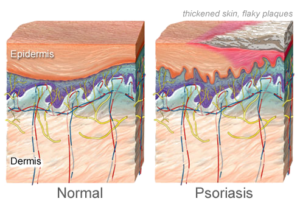Psoriasis The history of this disease dates back to the early Egyptians, it may be the oldest known skin disease. It is mentioned in many ancient texts, including the bible. The Bible uses the word tsaraat meaning skin disease. The Egyptians even describe a salve of a number of herbs, that is applied to the area. The patient then sits in the sun for a time. Sitting in the sun would increase the production of Vitamin D, which has been suggested as a supplement sufferers should take.
The sun also has ultraviolet rays which are anti-bacterial. This would have assisted in controlling infection in the irritated skin.
Some Egyptian mummies when unwrapped showed signs of psoriasis. Hippocrates introduced the use of tar. This treatment lasted for a couple of thousand years and has only lately been discontinued. He also added arsenic to be applied to the skin. Not sure that was one of his better moments.
Originally sufferers were thought to have leprosy, and separated from the population for fear of contaminating others. During medieval times, sufferers were forced to warn others of their arrival by ringing a bell. Eventually, in the 1800s psoriasis was separated from leprosy and given the name psoriasis, a Greek word meaning “to itch”. The Englishman Dr. Robert Willan, around 1809, first recognized psoriasis as a specific clinical entity and described it accurately.
Other articles in this series
- Psoriasis treatments, the good, the bad and the ugly
- Psoriasis safe and effective long-term treatment

